Field Basics
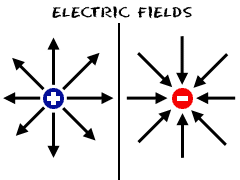 Scientists understood why forces acted the way they did when objects
touched. The idea that confused them was forces that acted at a
distance without touching.
Scientists understood why forces acted the way they did when objects
touched. The idea that confused them was forces that acted at a
distance without touching. Think of examples such as gravitational force, electric force, and magnetic force. To help them explain what was happening, they used the idea of "field". They imagined that there was an area around the object, and anything that entered would feel a force. We say, for example, that the Moon has a gravitational field around it, and if you get close to the Moon, it will pull you down to its surface.
Electric Fields
An electric field describes the funky area near any electrically-charged object. Scientists don’t use the word "funky", but it works. It could also be called an electrostatic field. Any other charge that enters that area will feel a force, and the original object will also feel that force (Newton's Third Law). It's kind of like a spider sitting at the center of a web.
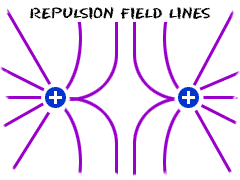 A normal field is a vector,
and is represented by arrows. The Earth's (or any planet's)
gravitational field would be drawn as arrows pointing toward the ground.
A field vector shows the direction of the effect on an object entering
the field. Gravity acts downward.
A normal field is a vector,
and is represented by arrows. The Earth's (or any planet's)
gravitational field would be drawn as arrows pointing toward the ground.
A field vector shows the direction of the effect on an object entering
the field. Gravity acts downward.
For an electric field, things are a little more complicated, since there are two kinds of charges, and some combinations attract while others repel. In order to be in agreement with each other, physicists decided that they would always use positive charges to determine the direction of the effect of a field. So, if the central charge was positive, and you put another positive charge near it, that second charge would be repelled outward. So the field vectors for a central positive charge point outward. If the central charge is negative, a positive charge placed nearby would be attracted toward the center charge, so the field vectors for a central negative charge point inward.
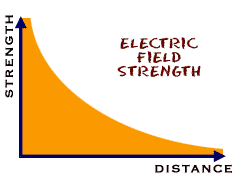 Since fields are directly related to the forces they exert, their
strength decreases with distance, and increases with the size of the
charge producing the field. When you put charges near one another, their
fields interact and change shape. This results in changes in the PE of
the objects, and generates forces of repulsion or attraction.
Since fields are directly related to the forces they exert, their
strength decreases with distance, and increases with the size of the
charge producing the field. When you put charges near one another, their
fields interact and change shape. This results in changes in the PE of
the objects, and generates forces of repulsion or attraction.
Electric fields can also be created by magnetic fields. Magnetism and electricity are always connected.
ELECTRICITY - POWERPOINT - GO to -
- ELECTRICAL CHARGES & CURRENTS, CHAPTER 12
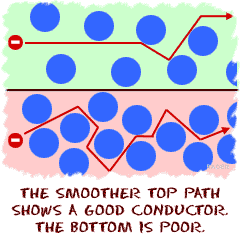 There are many materials that allow charges to move easily. They are called conductors. Conductors have the quality of conductivity.
I guess that's not a lot of help for you. The reality is that you just
need to understand the difference between those two words. The conductor
is the object that allows charge to flow. Conductivity is a quality
related to the conductor. A material that is a good conductor gives very
little resistance to the flow of charge. This flow of charge is called an electric current. A good conductor has high conductivity.
There are many materials that allow charges to move easily. They are called conductors. Conductors have the quality of conductivity.
I guess that's not a lot of help for you. The reality is that you just
need to understand the difference between those two words. The conductor
is the object that allows charge to flow. Conductivity is a quality
related to the conductor. A material that is a good conductor gives very
little resistance to the flow of charge. This flow of charge is called an electric current. A good conductor has high conductivity.

 (2) There are some conductors that are not metals. Carbon is the best example.
(2) There are some conductors that are not metals. Carbon is the best example.

 So what happens if you have separated charges and you connect them with
conducting material? Providing a path for charges to move, and making
that path out of materials that allow easy movement, results in a flow
of charge (electrons) called a current. The electrons
will flow from a location that is negative to one that is positive.
This can happen quickly and then stop, as with a spark. Or, in the case
of a battery connected to a conducting loop (called a circuit. ), it
continues to happen until the battery runs out of energy.
So what happens if you have separated charges and you connect them with
conducting material? Providing a path for charges to move, and making
that path out of materials that allow easy movement, results in a flow
of charge (electrons) called a current. The electrons
will flow from a location that is negative to one that is positive.
This can happen quickly and then stop, as with a spark. Or, in the case
of a battery connected to a conducting loop (called a circuit. ), it
continues to happen until the battery runs out of energy. 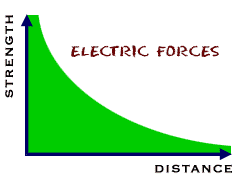 Scientists discovered that opposite charges attract, and like charges
repel. So positive-positive and negative-negative would repel, while
positive-negative would attract. Physicists use the term electric force
to describe these attractions and repulsions. The electric forces are
much stronger when negative charges are closer to positive charges. The
further apart two charges are, the weaker the electric force. Also, the
greater the charges, the greater the electric force will be.
Scientists discovered that opposite charges attract, and like charges
repel. So positive-positive and negative-negative would repel, while
positive-negative would attract. Physicists use the term electric force
to describe these attractions and repulsions. The electric forces are
much stronger when negative charges are closer to positive charges. The
further apart two charges are, the weaker the electric force. Also, the
greater the charges, the greater the electric force will be.
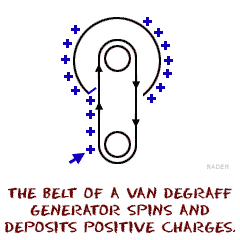 Atoms start out with the same number of negative charges (electrons), and positive charges (protons).
Under certain conditions, electrons can be removed from, or added to
atoms. Removing electrons would leave the atom with more positives than
negatives, and we call this a positive ion (An ion is a charged atom).
Conversely, adding electrons to an atom would result in a negative ion.
If you do this enough times, you can make an object positive or
negative.
Atoms start out with the same number of negative charges (electrons), and positive charges (protons).
Under certain conditions, electrons can be removed from, or added to
atoms. Removing electrons would leave the atom with more positives than
negatives, and we call this a positive ion (An ion is a charged atom).
Conversely, adding electrons to an atom would result in a negative ion.
If you do this enough times, you can make an object positive or
negative.
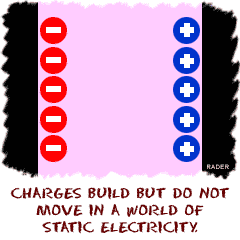 Electrons can move more easily in some objects than in others. If you
put a charge on things like glass, plastic, rubber, and wood, that
charge stays where you put it. We say the charges are static, and we
call this static electricity.
Electrons can move more easily in some objects than in others. If you
put a charge on things like glass, plastic, rubber, and wood, that
charge stays where you put it. We say the charges are static, and we
call this static electricity. 

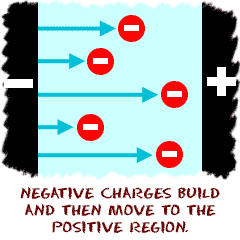 Electricity is related to charges,
and both electrons and protons carry a charge. The amount of the charge
is the same for each particle, but opposite in sign.
Electricity is related to charges,
and both electrons and protons carry a charge. The amount of the charge
is the same for each particle, but opposite in sign.